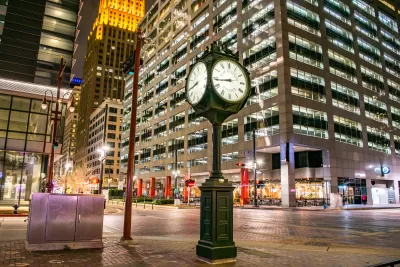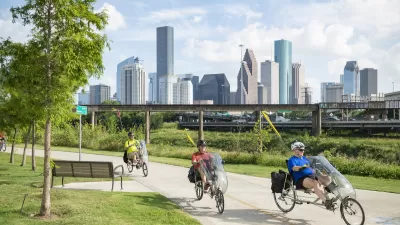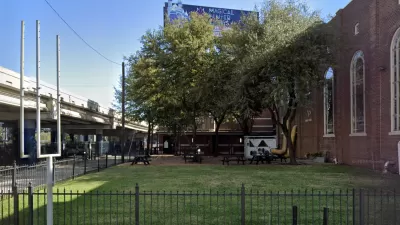A seven-block stretch of Main Street will be permanently blocked off to traffic and enhanced to create a vibrant, pedestrian friendly zone.

“Houston is finally tackling its walkability issue head-on” by transforming a seven-block portion of downtown’s Main Street into a car-free corridor, according to an article in Chron. Renee Yan reports the project, called “More Space: Mainstreet 2.0,” is in its final design and engineering phase and will likely break ground next year. In addition to lighting, stormwater, and aesthetic improvements, the street will be raised so it is level with the sidewalk. Work is expected to be completed in time for Houston to host the 2026 FIFA World Cup matches.
The project was inspired by an initiative the city undertook in 2021 to support local businesses during the pandemic. Chron previously reported that “[t]he city launched it as a pilot program to restrict car traffic and allow restaurants and bars to create gathering spaces along Main Street.” The program was very popular with residents and business owners, so after it expired in 2023, the city council voted unanimously to make it permanent.
Houston isn’t the only city to make pandemic-era car-free street projects permanent after positive reaction from the public and boosts to local restaurants. Other places in the U.S. that have done so include San Francisco’s John F. Kennedy Drive; 34th Avenue in Jackson Heights, Queens; multiple streets in Manhattan’s Meatpacking District in New York City; California Ave in Palo Alto.
FULL STORY: Project aims to make Downtown Houston zone more walkable by 2026

Study: Maui’s Plan to Convert Vacation Rentals to Long-Term Housing Could Cause Nearly $1 Billion Economic Loss
The plan would reduce visitor accommodation by 25,% resulting in 1,900 jobs lost.

North Texas Transit Leaders Tout Benefits of TOD for Growing Region
At a summit focused on transit-oriented development, policymakers discussed how North Texas’ expanded light rail system can serve as a tool for economic growth.

Why Should We Subsidize Public Transportation?
Many public transit agencies face financial stress due to rising costs, declining fare revenue, and declining subsidies. Transit advocates must provide a strong business case for increasing public transit funding.

How to Make US Trains Faster
Changes to boarding platforms and a switch to electric trains could improve U.S. passenger rail service without the added cost of high-speed rail.

Columbia’s Revitalized ‘Loop’ Is a Hub for Local Entrepreneurs
A focus on small businesses is helping a commercial corridor in Columbia, Missouri thrive.

Invasive Insect Threatens Minnesota’s Ash Forests
The Emerald Ash Borer is a rapidly spreading invasive pest threatening Minnesota’s ash trees, and homeowners are encouraged to plant diverse replacement species, avoid moving ash firewood, and monitor for signs of infestation.
Urban Design for Planners 1: Software Tools
This six-course series explores essential urban design concepts using open source software and equips planners with the tools they need to participate fully in the urban design process.
Planning for Universal Design
Learn the tools for implementing Universal Design in planning regulations.
City of Santa Clarita
Ascent Environmental
Institute for Housing and Urban Development Studies (IHS)
City of Grandview
Harvard GSD Executive Education
Toledo-Lucas County Plan Commissions
Salt Lake City
NYU Wagner Graduate School of Public Service





























